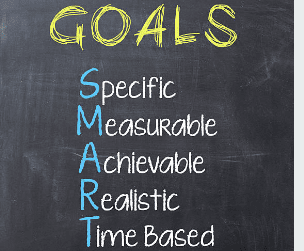The Complete Guide to Goals and Goal Setting
Learn how to set goals for yourself and use them in your life to achieve success.

Selfpause Affirmation App
Download the app to get 1,000’s of affirmation meditations and everything you need to write, record and listen to your own.
Goals are ideas about the future that a person has in mind. They are the things that they wish to achieve and want to reach within a finite period of time. They often set deadlines to meet their goals. Then, once they have set them, they work hard to reach them. Goal-setting is an important part of the development process.
Objectives

When we set our goals, we are trying to achieve something in the future. Goals are ideas of what we would like to achieve and how we would like to feel. Goals are often accompanied by a deadline that must be reached. These goals are a good way to get a sense of accomplishment.
When setting goals, keep in mind that they should be relevant to the person who is responsible for achieving them. If you have someone in your organization who is responsible for the achievement of goals, they should be involved in the formulation process. A good goal is simple to understand and will get everyone pointing in the same direction.
Objectives are important to meet, because they help us realize our full potential. They also inspire us to believe in ourselves. In addition, they help us measure our progress, which will motivate us to work harder. However, goals without objectives may appear impossible to meet. Once you’ve achieved an objective, you’ll feel proud of yourself and will be motivated to keep working.
While goals are more general in nature, objectives are narrower and focus on specific outcomes. In other words, objectives are measurable, time-based milestones that must be met to accomplish the overall goal. Objectives can be intangible or tangible. A goal is a broad vision, but without an objective, it will likely never become a reality.
A SMART goal is one that is specific, measurable, achievable, relevant, and time-bound. In addition to being specific, SMART objectives are detailed, as they provide the necessary details to achieve the desired result. These goals are also more challenging.
Process-oriented goals

Process-oriented goals are a great way to develop productive work habits and maximize your skills. They also enable you to replace your goals every once in a while, keeping your eye on the big picture. For example, you might set a process goal to read leadership books, post questions on marketing professionals’ forums, volunteer to train employees twice a month, or apply for a new job every week.
Most people have trouble achieving their goals because they’re too focused on the outcome. Instead, focusing on the action required to reach that outcome is a much better way to succeed. By keeping your focus on the process rather than the outcome, you’ll find the process much more fun and rewarding. Using a process-oriented goal to achieve your goals can help you achieve your dreams faster.
A process goal can be set for a short period of time, such as a personal record. Another process goal may be an exercise session with specific measures of time and perceived exertion. The latter approach is often better suited for teams with tight deadlines. But you can also set goals that are longer term.
Process-oriented goals are more detailed than performance-oriented goals. They break down a situation or skill into steps so you can master the basic skills and make them automatic. These goals can be set with the help of a sport-specific coach. Aside from helping you reach your ultimate goal, process-oriented goals are more realistic and sustainable.
Process-oriented goals allow employees to put more of themselves into their work and develop their personal growth. This can be very effective for the company because it improves quality and employee satisfaction.
Outcome-oriented goals

The difference between time-bound and outcome-oriented goals lies in their focus on the end result. While time-bound goals must be connected to a timetable and are actionable, outcome-oriented goals focus on the end result rather than the process. This makes them more suitable for teams that need to perform actions with a tight deadline.
However, an outcome-oriented goal isn’t the best option for every situation. It can place a lot of unnecessary pressure on an individual. A person may experience a lot of stress until he or she reaches the goal. This can drive a person to give up if they are unable to handle the stress.
Process goals help individuals and teams reach a goal. Outcome-oriented goals, on the other hand, evaluate the goal and determine the next steps. While outcome goals are more focused on the final result, process goals are more focused on how to get there. These goals are often more detailed than outcome-oriented goals.
Outcome-oriented goals are easier to achieve and often have measurable outcomes. They are also much simpler to measure than process goals. For example, joining a running club and running five days a week may seem like an impossible goal. However, it is possible to set process goals that are more realistic. Instead of training five days a week for a marathon, an individual could join a track club and start running five times a week. This process goal may not be life-changing, but it will provide motivation.
While process goals are easy to measure and track, outcome goals require predictions of future events. By setting process goals and outcome goals, you’ll be more likely to achieve them.
Timeline

Creating a timeline for your goals can help you achieve them. Even complex goals can be achieved with a simple timeline. You can create one using basic office tools. Begin by writing down your goals for the next year. Then, create a five-year timeline using a template to guide you.
Make sure that your goals support your overall mission. Also, make sure that they don’t compete with other goals you may have. For example, if you are a new mother, you may not want to prioritize losing weight over staying healthy and maintaining your milk supply. A more realistic goal might be to get more sleep.
A good timeline will allow you to focus on the most important tasks. It helps you prioritize tasks and keep the team motivated. Remember, tasks change frequently, so a timeline can help you keep track of them. You can adjust the timeframe by adding or removing tasks, adjusting priority if necessary, and making sure your team gets the necessary resources to complete the tasks.
Once you’ve decided on your goals, create a timeline to visualize the journey to get there. You should start with the left end of the timeline and label it as ‘now’, and the right end as your desired end result. Then, plug in the steps that you’ll need to complete along the way. By completing your timeline, you’ll create a sense of urgency and commit yourself to finishing your goal.
By defining goals and assigning a timeline, you can complete tasks on time and organize your time effectively. Make sure that you set realistic goals, and make sure to measure your progress along the way. If you don’t, you may end up frustrated and bitter.
SMART goals

When drafting SMART goals, be sure to provide a clear and comprehensive description of your goal. This should include the time frame, location, and relevant event. The why of the goal should also be included. Without this information, your goals may seem vague and unrelated. In addition, you need to ensure that your goals are time-sensitive.
In addition to being relevant and time-bound, SMART goals should be measurable. This will help you gauge your progress and manage your energy. In addition, you’ll be able to measure how hard it is to achieve your goal. This is especially important if you’re trying to reach a professional goal. For instance, if you’re working on your goal with a team, you might want to celebrate every little win you make with them. This will inspire your teammates to keep working towards the bigger goal. Personal successes, on the other hand, should be celebrated with friends and family. After celebrating, it’s time to get back to work.
SMART goals are often used for business purposes, but they can be used to set personal goals as well. Creating SMART goals will help you define your purpose and help you live your life with intention. The key to success is to keep your goals simple, measurable, and achievable. You don’t want to get too ambitious or too focused on achieving a goal that is impossible to achieve.
The definition of a SMART goal is “specific, measurable, actionable, and attainable.” In other words, you want your goals to be specific, measurable, relevant, and time-bound. In addition, SMART goals must be clearly defined with a start and an end date.